Assessing Sustainable Technologies in Construction: A Detailed Report
VerifiedAdded on 2022/08/26
|15
|3383
|22
Report
AI Summary
This report delves into the realm of sustainable technologies in construction, emphasizing infrastructure sustainability and sustainable design. It explores the reasons behind sustainable infrastructure development, examining a range of sustainable technologies and their applications. The report highlights the importance of sustainable design, the role of BIM (Building Information Modeling) in achieving sustainable goals, and the use of sustainable infrastructure rating systems. It also discusses sustainable building development, including the concept of nearly zero-energy buildings (nZEB) and essential system elements for low or zero-energy performance. The report provides an overview of the challenges and advancements in sustainable construction practices, offering insights into the integration of BIM data and performance examination in the design phase, ultimately aiming for more feasible infrastructure solutions.
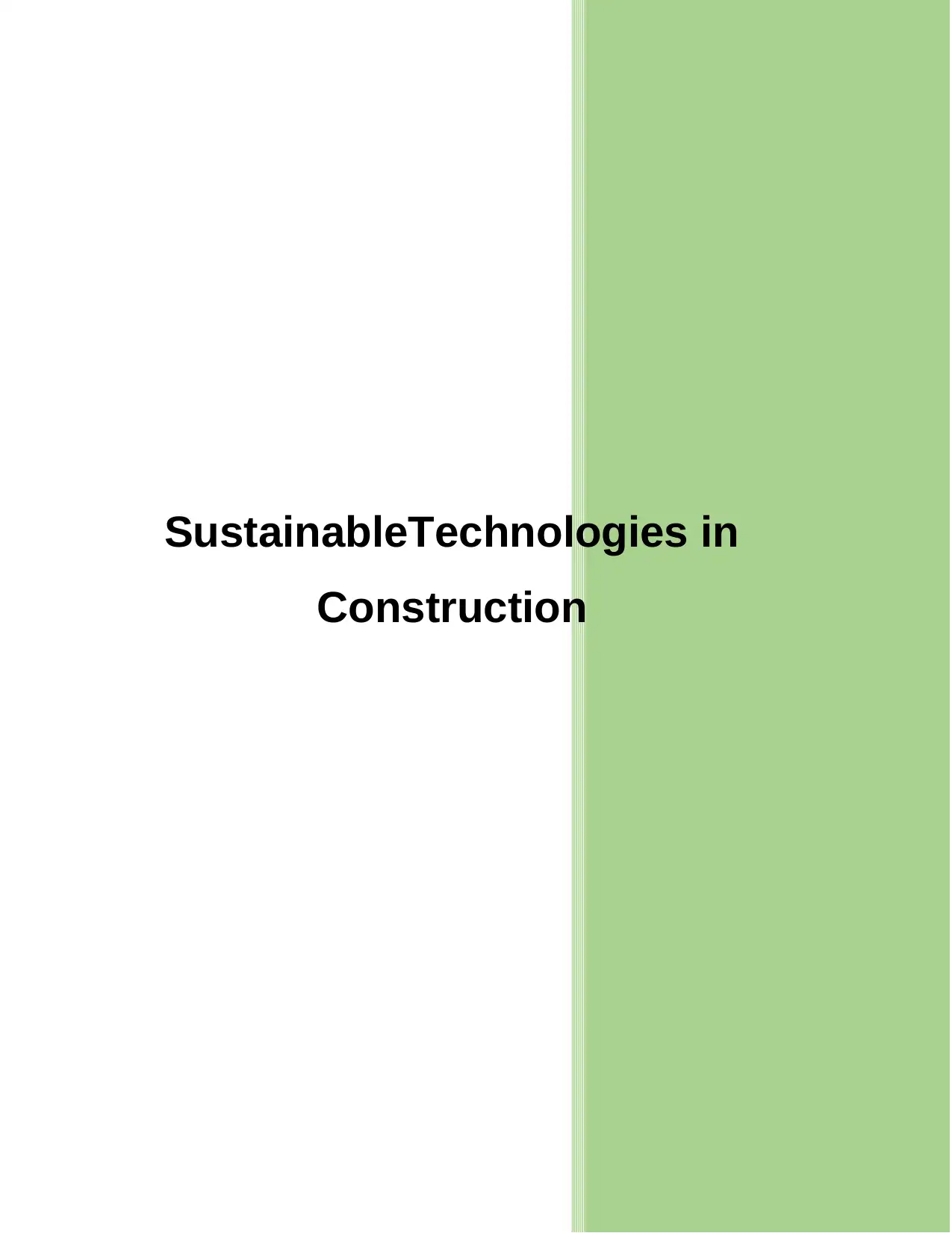
SustainableTechnologies in
Construction
Construction
Paraphrase This Document
Need a fresh take? Get an instant paraphrase of this document with our AI Paraphraser
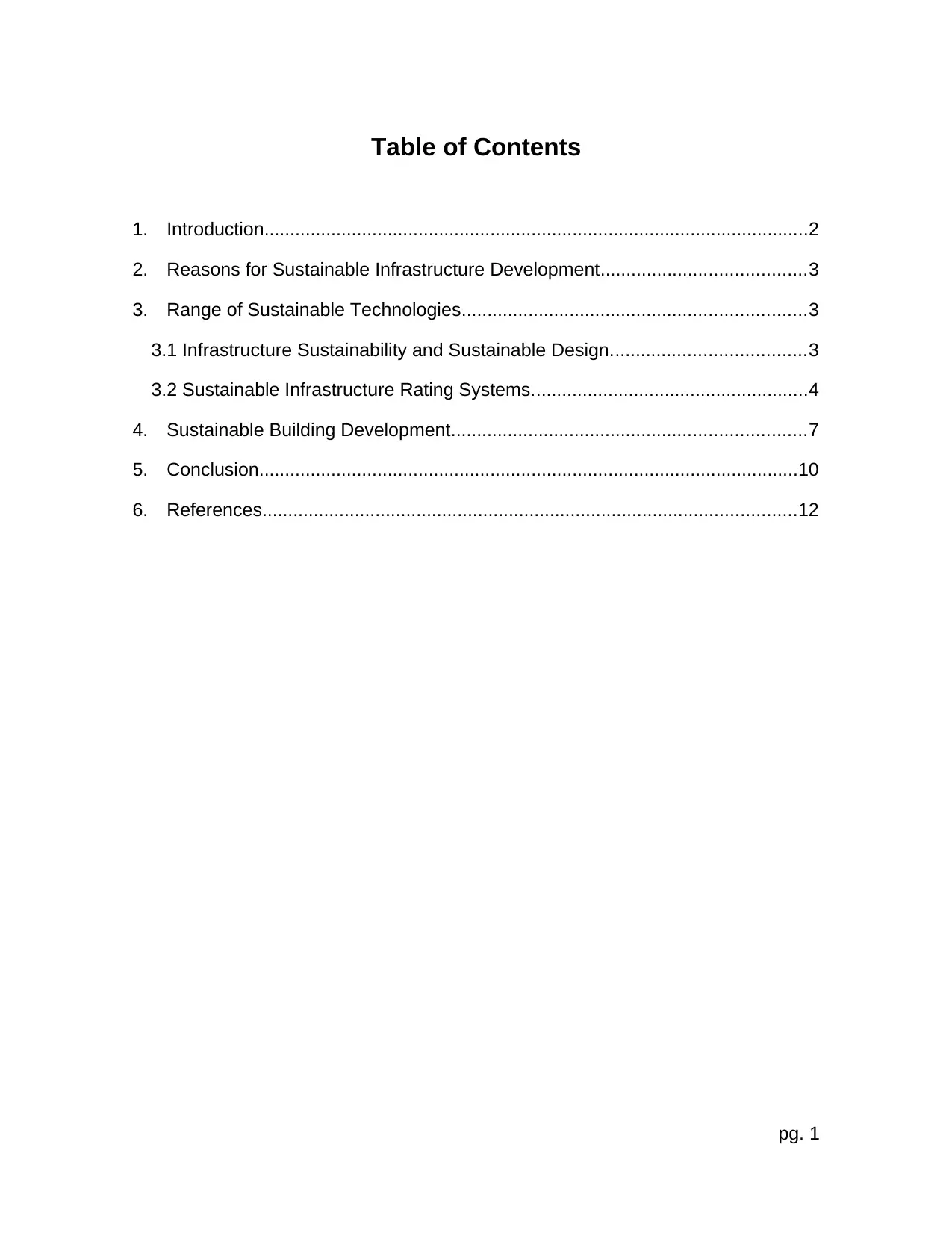
Table of Contents
1. Introduction..........................................................................................................2
2. Reasons for Sustainable Infrastructure Development........................................3
3. Range of Sustainable Technologies...................................................................3
3.1 Infrastructure Sustainability and Sustainable Design......................................3
3.2 Sustainable Infrastructure Rating Systems......................................................4
4. Sustainable Building Development.....................................................................7
5. Conclusion.........................................................................................................10
6. References........................................................................................................12
pg. 1
1. Introduction..........................................................................................................2
2. Reasons for Sustainable Infrastructure Development........................................3
3. Range of Sustainable Technologies...................................................................3
3.1 Infrastructure Sustainability and Sustainable Design......................................3
3.2 Sustainable Infrastructure Rating Systems......................................................4
4. Sustainable Building Development.....................................................................7
5. Conclusion.........................................................................................................10
6. References........................................................................................................12
pg. 1
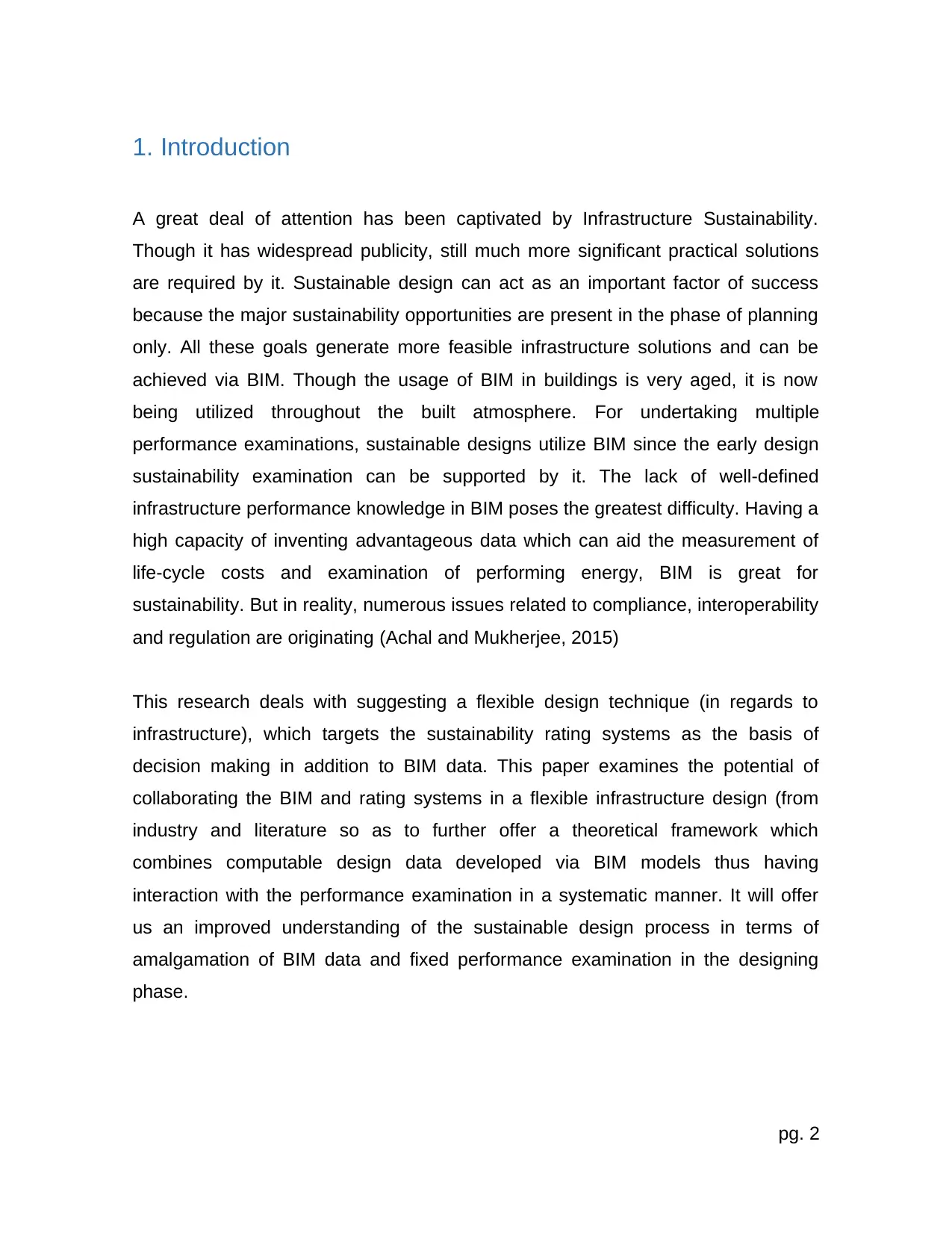
1. Introduction
A great deal of attention has been captivated by Infrastructure Sustainability.
Though it has widespread publicity, still much more significant practical solutions
are required by it. Sustainable design can act as an important factor of success
because the major sustainability opportunities are present in the phase of planning
only. All these goals generate more feasible infrastructure solutions and can be
achieved via BIM. Though the usage of BIM in buildings is very aged, it is now
being utilized throughout the built atmosphere. For undertaking multiple
performance examinations, sustainable designs utilize BIM since the early design
sustainability examination can be supported by it. The lack of well-defined
infrastructure performance knowledge in BIM poses the greatest difficulty. Having a
high capacity of inventing advantageous data which can aid the measurement of
life-cycle costs and examination of performing energy, BIM is great for
sustainability. But in reality, numerous issues related to compliance, interoperability
and regulation are originating (Achal and Mukherjee, 2015)
This research deals with suggesting a flexible design technique (in regards to
infrastructure), which targets the sustainability rating systems as the basis of
decision making in addition to BIM data. This paper examines the potential of
collaborating the BIM and rating systems in a flexible infrastructure design (from
industry and literature so as to further offer a theoretical framework which
combines computable design data developed via BIM models thus having
interaction with the performance examination in a systematic manner. It will offer
us an improved understanding of the sustainable design process in terms of
amalgamation of BIM data and fixed performance examination in the designing
phase.
pg. 2
A great deal of attention has been captivated by Infrastructure Sustainability.
Though it has widespread publicity, still much more significant practical solutions
are required by it. Sustainable design can act as an important factor of success
because the major sustainability opportunities are present in the phase of planning
only. All these goals generate more feasible infrastructure solutions and can be
achieved via BIM. Though the usage of BIM in buildings is very aged, it is now
being utilized throughout the built atmosphere. For undertaking multiple
performance examinations, sustainable designs utilize BIM since the early design
sustainability examination can be supported by it. The lack of well-defined
infrastructure performance knowledge in BIM poses the greatest difficulty. Having a
high capacity of inventing advantageous data which can aid the measurement of
life-cycle costs and examination of performing energy, BIM is great for
sustainability. But in reality, numerous issues related to compliance, interoperability
and regulation are originating (Achal and Mukherjee, 2015)
This research deals with suggesting a flexible design technique (in regards to
infrastructure), which targets the sustainability rating systems as the basis of
decision making in addition to BIM data. This paper examines the potential of
collaborating the BIM and rating systems in a flexible infrastructure design (from
industry and literature so as to further offer a theoretical framework which
combines computable design data developed via BIM models thus having
interaction with the performance examination in a systematic manner. It will offer
us an improved understanding of the sustainable design process in terms of
amalgamation of BIM data and fixed performance examination in the designing
phase.
pg. 2
⊘ This is a preview!⊘
Do you want full access?
Subscribe today to unlock all pages.

Trusted by 1+ million students worldwide
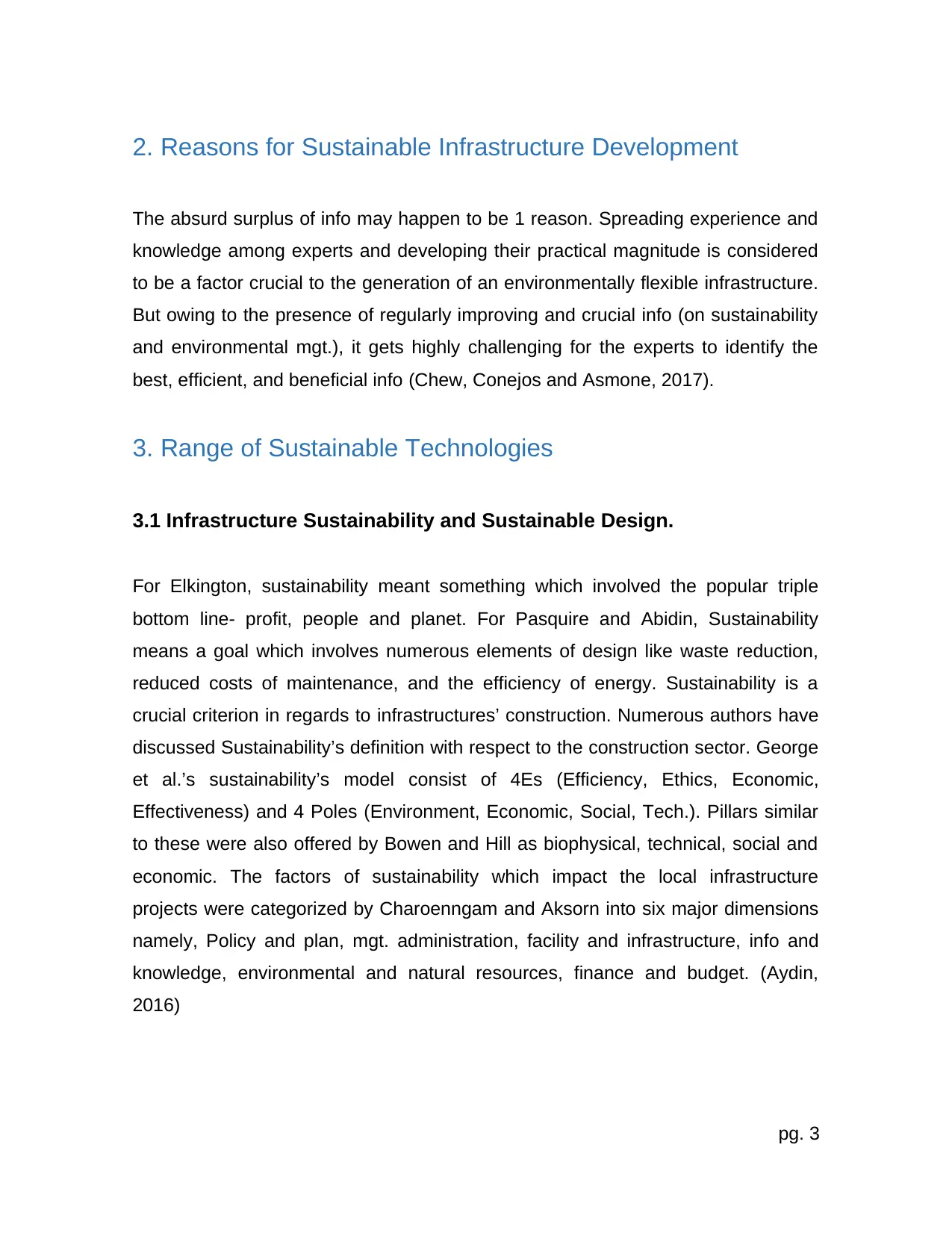
2. Reasons for Sustainable Infrastructure Development
The absurd surplus of info may happen to be 1 reason. Spreading experience and
knowledge among experts and developing their practical magnitude is considered
to be a factor crucial to the generation of an environmentally flexible infrastructure.
But owing to the presence of regularly improving and crucial info (on sustainability
and environmental mgt.), it gets highly challenging for the experts to identify the
best, efficient, and beneficial info (Chew, Conejos and Asmone, 2017).
3. Range of Sustainable Technologies
3.1 Infrastructure Sustainability and Sustainable Design.
For Elkington, sustainability meant something which involved the popular triple
bottom line- profit, people and planet. For Pasquire and Abidin, Sustainability
means a goal which involves numerous elements of design like waste reduction,
reduced costs of maintenance, and the efficiency of energy. Sustainability is a
crucial criterion in regards to infrastructures’ construction. Numerous authors have
discussed Sustainability’s definition with respect to the construction sector. George
et al.’s sustainability’s model consist of 4Es (Efficiency, Ethics, Economic,
Effectiveness) and 4 Poles (Environment, Economic, Social, Tech.). Pillars similar
to these were also offered by Bowen and Hill as biophysical, technical, social and
economic. The factors of sustainability which impact the local infrastructure
projects were categorized by Charoenngam and Aksorn into six major dimensions
namely, Policy and plan, mgt. administration, facility and infrastructure, info and
knowledge, environmental and natural resources, finance and budget. (Aydin,
2016)
pg. 3
The absurd surplus of info may happen to be 1 reason. Spreading experience and
knowledge among experts and developing their practical magnitude is considered
to be a factor crucial to the generation of an environmentally flexible infrastructure.
But owing to the presence of regularly improving and crucial info (on sustainability
and environmental mgt.), it gets highly challenging for the experts to identify the
best, efficient, and beneficial info (Chew, Conejos and Asmone, 2017).
3. Range of Sustainable Technologies
3.1 Infrastructure Sustainability and Sustainable Design.
For Elkington, sustainability meant something which involved the popular triple
bottom line- profit, people and planet. For Pasquire and Abidin, Sustainability
means a goal which involves numerous elements of design like waste reduction,
reduced costs of maintenance, and the efficiency of energy. Sustainability is a
crucial criterion in regards to infrastructures’ construction. Numerous authors have
discussed Sustainability’s definition with respect to the construction sector. George
et al.’s sustainability’s model consist of 4Es (Efficiency, Ethics, Economic,
Effectiveness) and 4 Poles (Environment, Economic, Social, Tech.). Pillars similar
to these were also offered by Bowen and Hill as biophysical, technical, social and
economic. The factors of sustainability which impact the local infrastructure
projects were categorized by Charoenngam and Aksorn into six major dimensions
namely, Policy and plan, mgt. administration, facility and infrastructure, info and
knowledge, environmental and natural resources, finance and budget. (Aydin,
2016)
pg. 3
Paraphrase This Document
Need a fresh take? Get an instant paraphrase of this document with our AI Paraphraser
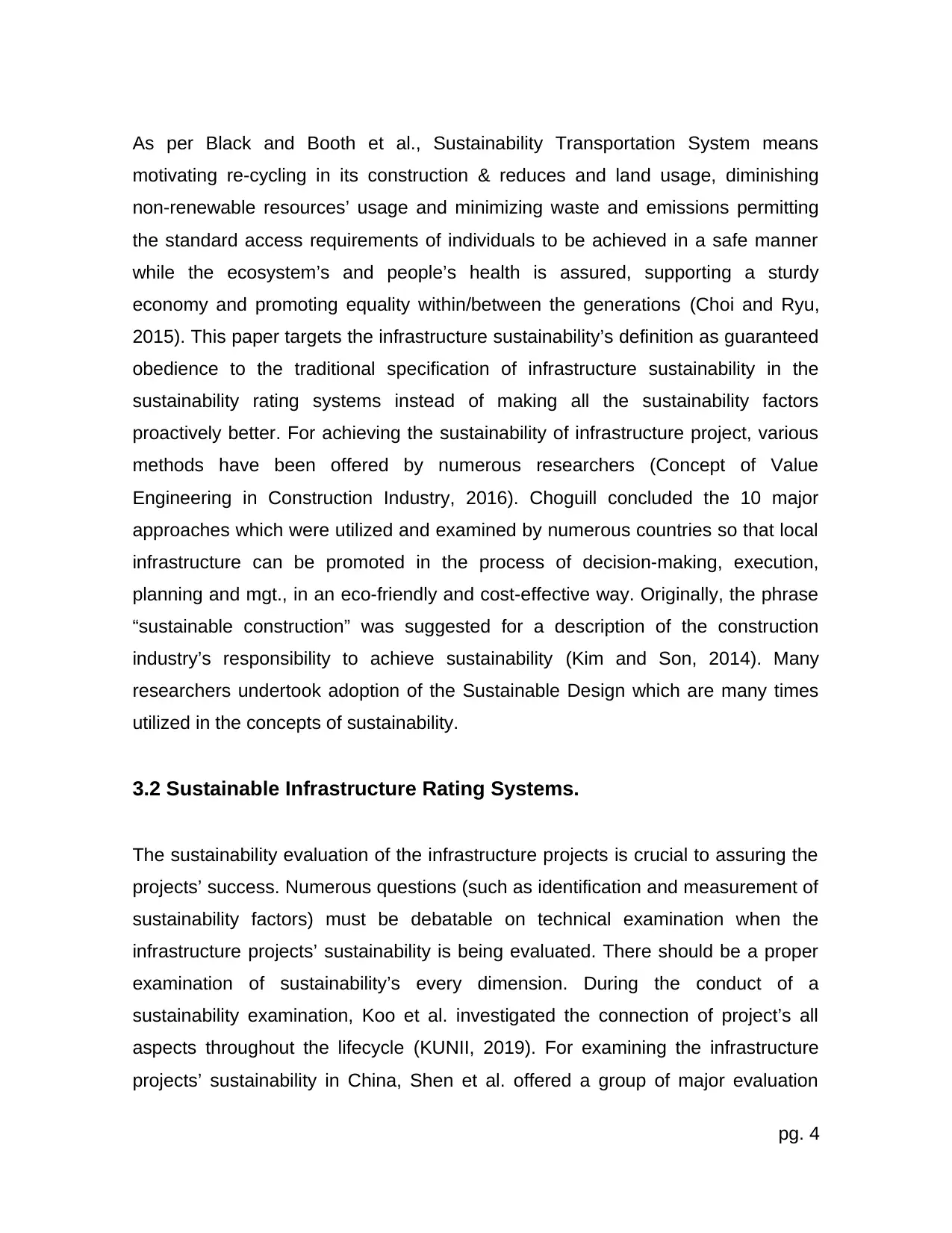
As per Black and Booth et al., Sustainability Transportation System means
motivating re-cycling in its construction & reduces and land usage, diminishing
non-renewable resources’ usage and minimizing waste and emissions permitting
the standard access requirements of individuals to be achieved in a safe manner
while the ecosystem’s and people’s health is assured, supporting a sturdy
economy and promoting equality within/between the generations (Choi and Ryu,
2015). This paper targets the infrastructure sustainability’s definition as guaranteed
obedience to the traditional specification of infrastructure sustainability in the
sustainability rating systems instead of making all the sustainability factors
proactively better. For achieving the sustainability of infrastructure project, various
methods have been offered by numerous researchers (Concept of Value
Engineering in Construction Industry, 2016). Choguill concluded the 10 major
approaches which were utilized and examined by numerous countries so that local
infrastructure can be promoted in the process of decision-making, execution,
planning and mgt., in an eco-friendly and cost-effective way. Originally, the phrase
“sustainable construction” was suggested for a description of the construction
industry’s responsibility to achieve sustainability (Kim and Son, 2014). Many
researchers undertook adoption of the Sustainable Design which are many times
utilized in the concepts of sustainability.
3.2 Sustainable Infrastructure Rating Systems.
The sustainability evaluation of the infrastructure projects is crucial to assuring the
projects’ success. Numerous questions (such as identification and measurement of
sustainability factors) must be debatable on technical examination when the
infrastructure projects’ sustainability is being evaluated. There should be a proper
examination of sustainability’s every dimension. During the conduct of a
sustainability examination, Koo et al. investigated the connection of project’s all
aspects throughout the lifecycle (KUNII, 2019). For examining the infrastructure
projects’ sustainability in China, Shen et al. offered a group of major evaluation
pg. 4
motivating re-cycling in its construction & reduces and land usage, diminishing
non-renewable resources’ usage and minimizing waste and emissions permitting
the standard access requirements of individuals to be achieved in a safe manner
while the ecosystem’s and people’s health is assured, supporting a sturdy
economy and promoting equality within/between the generations (Choi and Ryu,
2015). This paper targets the infrastructure sustainability’s definition as guaranteed
obedience to the traditional specification of infrastructure sustainability in the
sustainability rating systems instead of making all the sustainability factors
proactively better. For achieving the sustainability of infrastructure project, various
methods have been offered by numerous researchers (Concept of Value
Engineering in Construction Industry, 2016). Choguill concluded the 10 major
approaches which were utilized and examined by numerous countries so that local
infrastructure can be promoted in the process of decision-making, execution,
planning and mgt., in an eco-friendly and cost-effective way. Originally, the phrase
“sustainable construction” was suggested for a description of the construction
industry’s responsibility to achieve sustainability (Kim and Son, 2014). Many
researchers undertook adoption of the Sustainable Design which are many times
utilized in the concepts of sustainability.
3.2 Sustainable Infrastructure Rating Systems.
The sustainability evaluation of the infrastructure projects is crucial to assuring the
projects’ success. Numerous questions (such as identification and measurement of
sustainability factors) must be debatable on technical examination when the
infrastructure projects’ sustainability is being evaluated. There should be a proper
examination of sustainability’s every dimension. During the conduct of a
sustainability examination, Koo et al. investigated the connection of project’s all
aspects throughout the lifecycle (KUNII, 2019). For examining the infrastructure
projects’ sustainability in China, Shen et al. offered a group of major evaluation
pg. 4
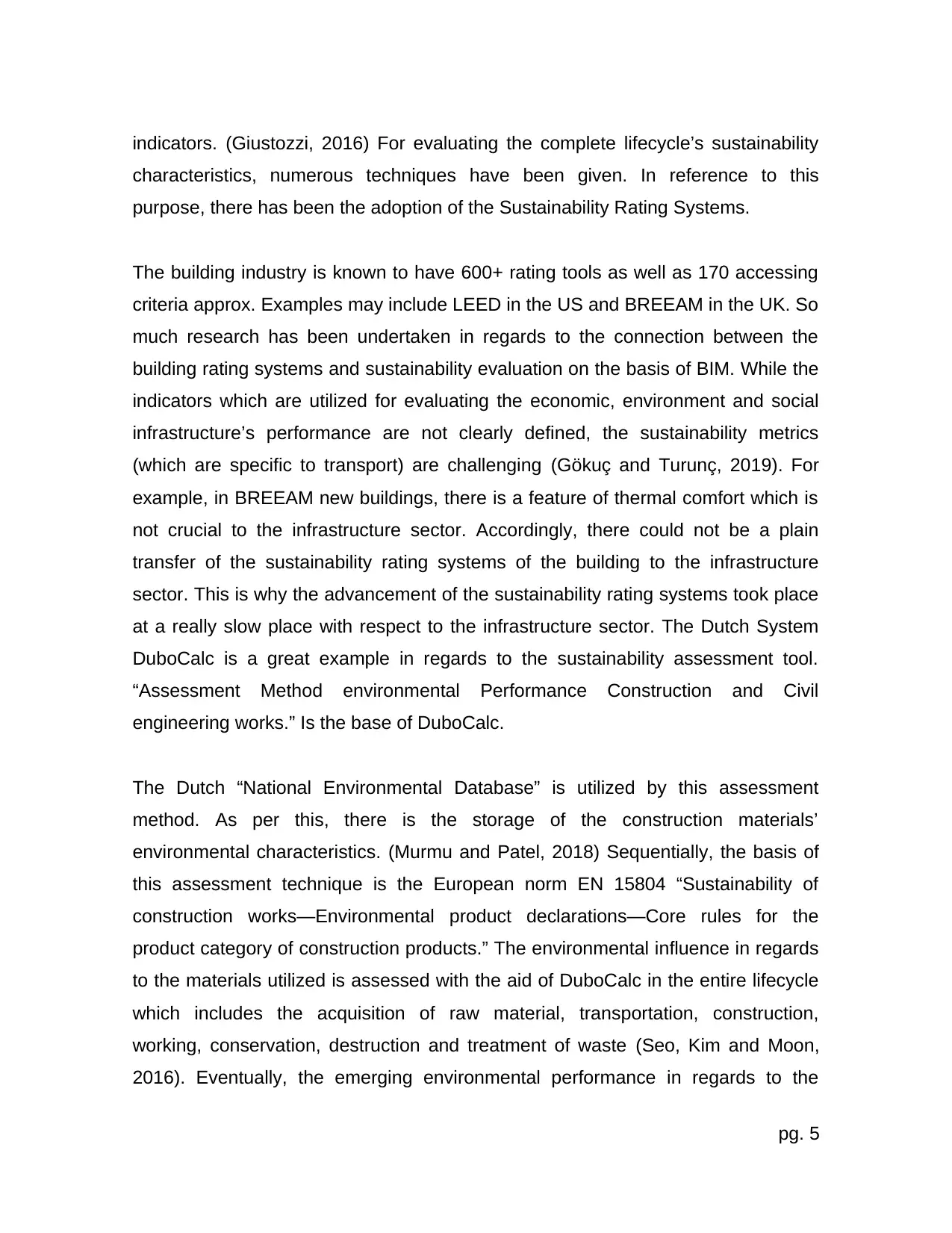
indicators. (Giustozzi, 2016) For evaluating the complete lifecycle’s sustainability
characteristics, numerous techniques have been given. In reference to this
purpose, there has been the adoption of the Sustainability Rating Systems.
The building industry is known to have 600+ rating tools as well as 170 accessing
criteria approx. Examples may include LEED in the US and BREEAM in the UK. So
much research has been undertaken in regards to the connection between the
building rating systems and sustainability evaluation on the basis of BIM. While the
indicators which are utilized for evaluating the economic, environment and social
infrastructure’s performance are not clearly defined, the sustainability metrics
(which are specific to transport) are challenging (Gökuç and Turunç, 2019). For
example, in BREEAM new buildings, there is a feature of thermal comfort which is
not crucial to the infrastructure sector. Accordingly, there could not be a plain
transfer of the sustainability rating systems of the building to the infrastructure
sector. This is why the advancement of the sustainability rating systems took place
at a really slow place with respect to the infrastructure sector. The Dutch System
DuboCalc is a great example in regards to the sustainability assessment tool.
“Assessment Method environmental Performance Construction and Civil
engineering works.” Is the base of DuboCalc.
The Dutch “National Environmental Database” is utilized by this assessment
method. As per this, there is the storage of the construction materials’
environmental characteristics. (Murmu and Patel, 2018) Sequentially, the basis of
this assessment technique is the European norm EN 15804 “Sustainability of
construction works—Environmental product declarations—Core rules for the
product category of construction products.” The environmental influence in regards
to the materials utilized is assessed with the aid of DuboCalc in the entire lifecycle
which includes the acquisition of raw material, transportation, construction,
working, conservation, destruction and treatment of waste (Seo, Kim and Moon,
2016). Eventually, the emerging environmental performance in regards to the
pg. 5
characteristics, numerous techniques have been given. In reference to this
purpose, there has been the adoption of the Sustainability Rating Systems.
The building industry is known to have 600+ rating tools as well as 170 accessing
criteria approx. Examples may include LEED in the US and BREEAM in the UK. So
much research has been undertaken in regards to the connection between the
building rating systems and sustainability evaluation on the basis of BIM. While the
indicators which are utilized for evaluating the economic, environment and social
infrastructure’s performance are not clearly defined, the sustainability metrics
(which are specific to transport) are challenging (Gökuç and Turunç, 2019). For
example, in BREEAM new buildings, there is a feature of thermal comfort which is
not crucial to the infrastructure sector. Accordingly, there could not be a plain
transfer of the sustainability rating systems of the building to the infrastructure
sector. This is why the advancement of the sustainability rating systems took place
at a really slow place with respect to the infrastructure sector. The Dutch System
DuboCalc is a great example in regards to the sustainability assessment tool.
“Assessment Method environmental Performance Construction and Civil
engineering works.” Is the base of DuboCalc.
The Dutch “National Environmental Database” is utilized by this assessment
method. As per this, there is the storage of the construction materials’
environmental characteristics. (Murmu and Patel, 2018) Sequentially, the basis of
this assessment technique is the European norm EN 15804 “Sustainability of
construction works—Environmental product declarations—Core rules for the
product category of construction products.” The environmental influence in regards
to the materials utilized is assessed with the aid of DuboCalc in the entire lifecycle
which includes the acquisition of raw material, transportation, construction,
working, conservation, destruction and treatment of waste (Seo, Kim and Moon,
2016). Eventually, the emerging environmental performance in regards to the
pg. 5
⊘ This is a preview!⊘
Do you want full access?
Subscribe today to unlock all pages.

Trusted by 1+ million students worldwide
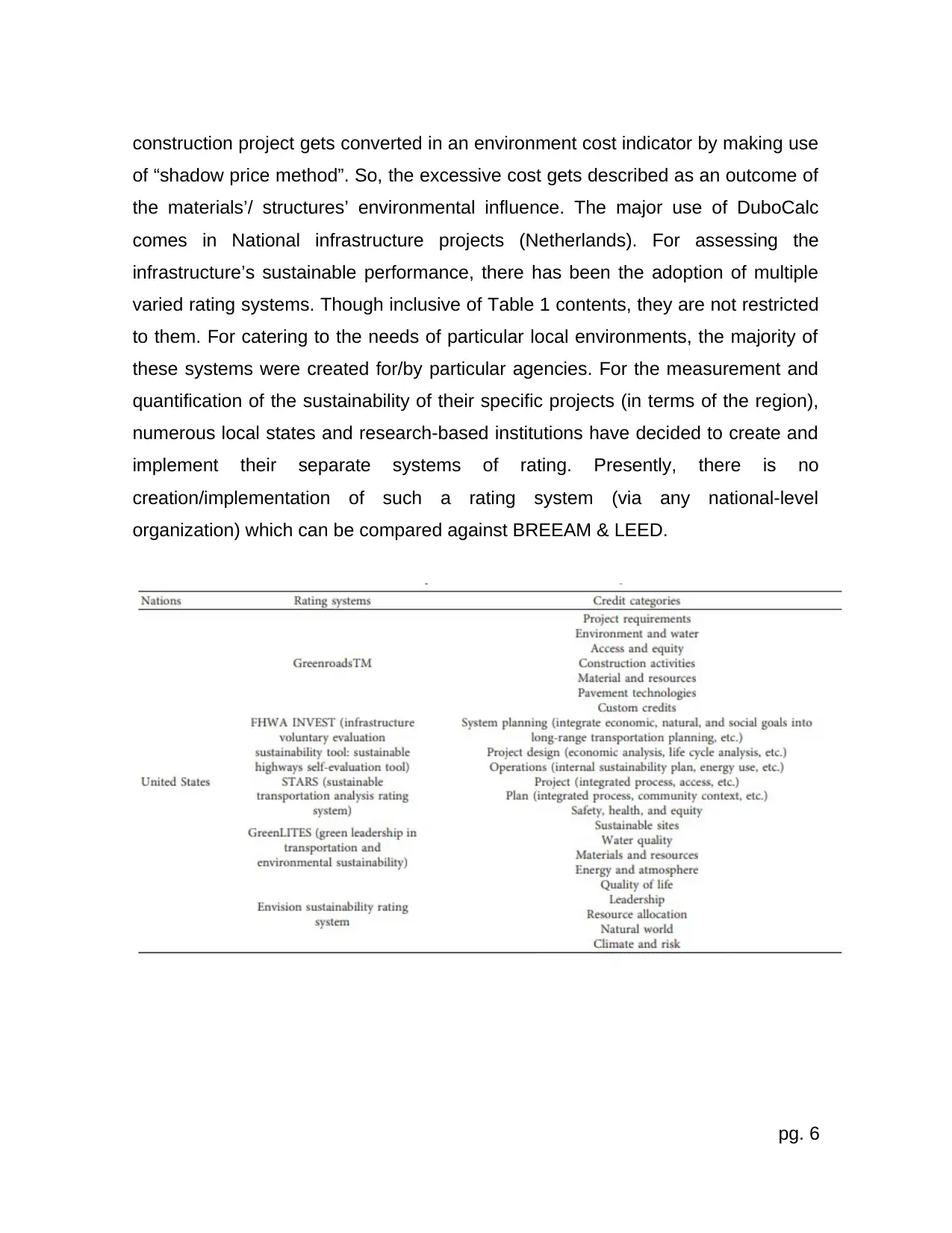
construction project gets converted in an environment cost indicator by making use
of “shadow price method”. So, the excessive cost gets described as an outcome of
the materials’/ structures’ environmental influence. The major use of DuboCalc
comes in National infrastructure projects (Netherlands). For assessing the
infrastructure’s sustainable performance, there has been the adoption of multiple
varied rating systems. Though inclusive of Table 1 contents, they are not restricted
to them. For catering to the needs of particular local environments, the majority of
these systems were created for/by particular agencies. For the measurement and
quantification of the sustainability of their specific projects (in terms of the region),
numerous local states and research-based institutions have decided to create and
implement their separate systems of rating. Presently, there is no
creation/implementation of such a rating system (via any national-level
organization) which can be compared against BREEAM & LEED.
pg. 6
of “shadow price method”. So, the excessive cost gets described as an outcome of
the materials’/ structures’ environmental influence. The major use of DuboCalc
comes in National infrastructure projects (Netherlands). For assessing the
infrastructure’s sustainable performance, there has been the adoption of multiple
varied rating systems. Though inclusive of Table 1 contents, they are not restricted
to them. For catering to the needs of particular local environments, the majority of
these systems were created for/by particular agencies. For the measurement and
quantification of the sustainability of their specific projects (in terms of the region),
numerous local states and research-based institutions have decided to create and
implement their separate systems of rating. Presently, there is no
creation/implementation of such a rating system (via any national-level
organization) which can be compared against BREEAM & LEED.
pg. 6
Paraphrase This Document
Need a fresh take? Get an instant paraphrase of this document with our AI Paraphraser
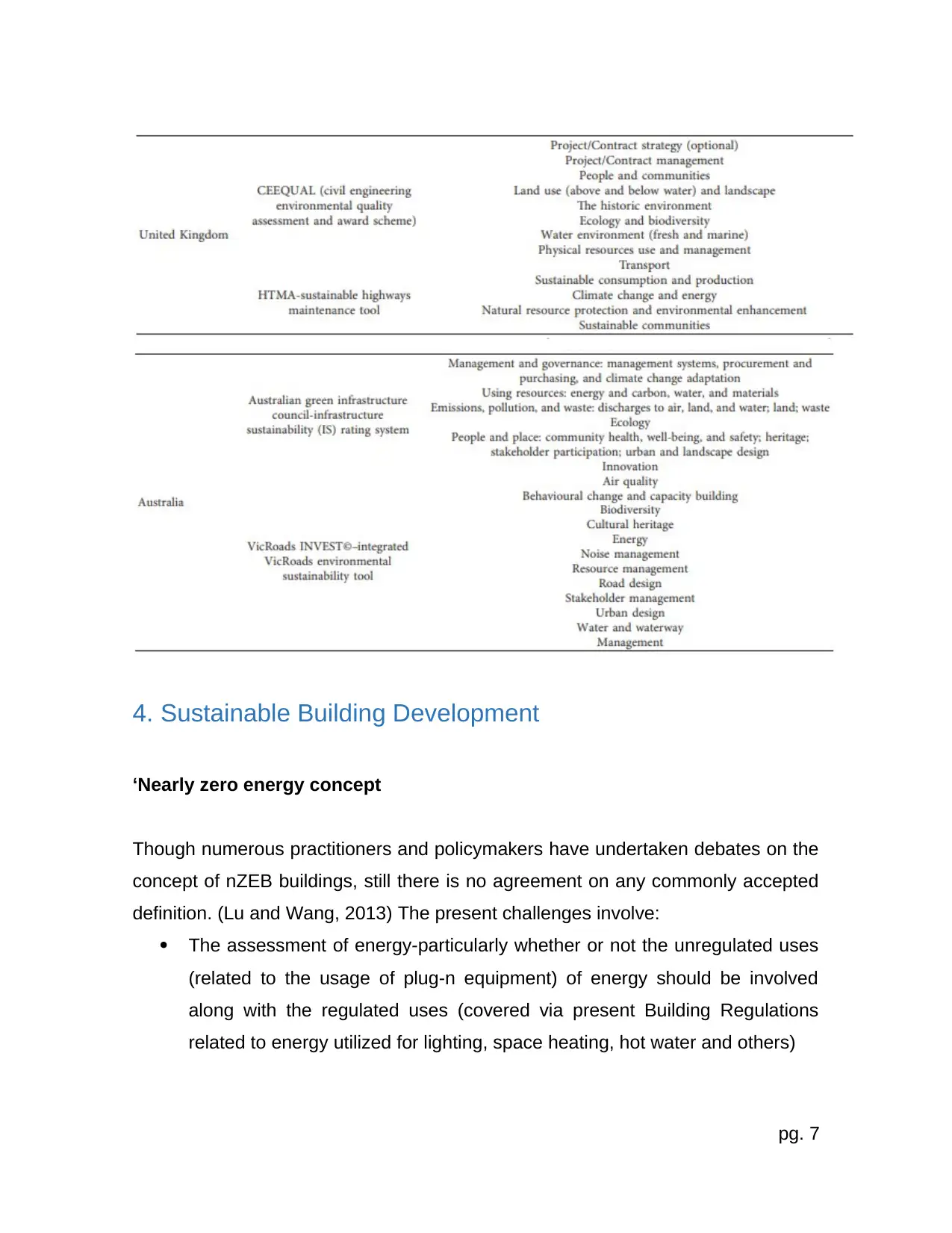
4. Sustainable Building Development
‘Nearly zero energy concept
Though numerous practitioners and policymakers have undertaken debates on the
concept of nZEB buildings, still there is no agreement on any commonly accepted
definition. (Lu and Wang, 2013) The present challenges involve:
The assessment of energy-particularly whether or not the unregulated uses
(related to the usage of plug-n equipment) of energy should be involved
along with the regulated uses (covered via present Building Regulations
related to energy utilized for lighting, space heating, hot water and others)
pg. 7
‘Nearly zero energy concept
Though numerous practitioners and policymakers have undertaken debates on the
concept of nZEB buildings, still there is no agreement on any commonly accepted
definition. (Lu and Wang, 2013) The present challenges involve:
The assessment of energy-particularly whether or not the unregulated uses
(related to the usage of plug-n equipment) of energy should be involved
along with the regulated uses (covered via present Building Regulations
related to energy utilized for lighting, space heating, hot water and others)
pg. 7
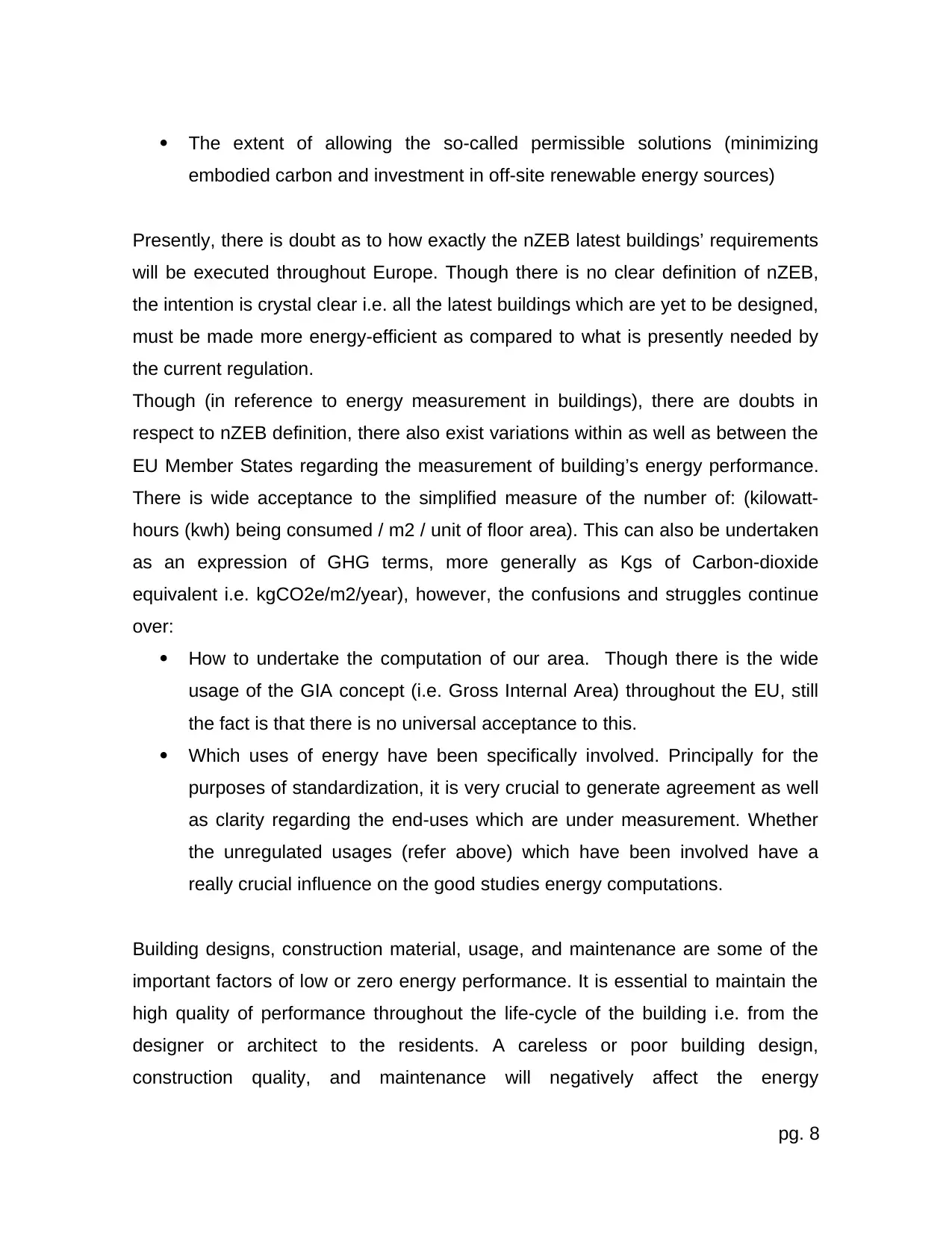
The extent of allowing the so-called permissible solutions (minimizing
embodied carbon and investment in off-site renewable energy sources)
Presently, there is doubt as to how exactly the nZEB latest buildings’ requirements
will be executed throughout Europe. Though there is no clear definition of nZEB,
the intention is crystal clear i.e. all the latest buildings which are yet to be designed,
must be made more energy-efficient as compared to what is presently needed by
the current regulation.
Though (in reference to energy measurement in buildings), there are doubts in
respect to nZEB definition, there also exist variations within as well as between the
EU Member States regarding the measurement of building’s energy performance.
There is wide acceptance to the simplified measure of the number of: (kilowatt-
hours (kwh) being consumed / m2 / unit of floor area). This can also be undertaken
as an expression of GHG terms, more generally as Kgs of Carbon-dioxide
equivalent i.e. kgCO2e/m2/year), however, the confusions and struggles continue
over:
How to undertake the computation of our area. Though there is the wide
usage of the GIA concept (i.e. Gross Internal Area) throughout the EU, still
the fact is that there is no universal acceptance to this.
Which uses of energy have been specifically involved. Principally for the
purposes of standardization, it is very crucial to generate agreement as well
as clarity regarding the end-uses which are under measurement. Whether
the unregulated usages (refer above) which have been involved have a
really crucial influence on the good studies energy computations.
Building designs, construction material, usage, and maintenance are some of the
important factors of low or zero energy performance. It is essential to maintain the
high quality of performance throughout the life-cycle of the building i.e. from the
designer or architect to the residents. A careless or poor building design,
construction quality, and maintenance will negatively affect the energy
pg. 8
embodied carbon and investment in off-site renewable energy sources)
Presently, there is doubt as to how exactly the nZEB latest buildings’ requirements
will be executed throughout Europe. Though there is no clear definition of nZEB,
the intention is crystal clear i.e. all the latest buildings which are yet to be designed,
must be made more energy-efficient as compared to what is presently needed by
the current regulation.
Though (in reference to energy measurement in buildings), there are doubts in
respect to nZEB definition, there also exist variations within as well as between the
EU Member States regarding the measurement of building’s energy performance.
There is wide acceptance to the simplified measure of the number of: (kilowatt-
hours (kwh) being consumed / m2 / unit of floor area). This can also be undertaken
as an expression of GHG terms, more generally as Kgs of Carbon-dioxide
equivalent i.e. kgCO2e/m2/year), however, the confusions and struggles continue
over:
How to undertake the computation of our area. Though there is the wide
usage of the GIA concept (i.e. Gross Internal Area) throughout the EU, still
the fact is that there is no universal acceptance to this.
Which uses of energy have been specifically involved. Principally for the
purposes of standardization, it is very crucial to generate agreement as well
as clarity regarding the end-uses which are under measurement. Whether
the unregulated usages (refer above) which have been involved have a
really crucial influence on the good studies energy computations.
Building designs, construction material, usage, and maintenance are some of the
important factors of low or zero energy performance. It is essential to maintain the
high quality of performance throughout the life-cycle of the building i.e. from the
designer or architect to the residents. A careless or poor building design,
construction quality, and maintenance will negatively affect the energy
pg. 8
⊘ This is a preview!⊘
Do you want full access?
Subscribe today to unlock all pages.

Trusted by 1+ million students worldwide
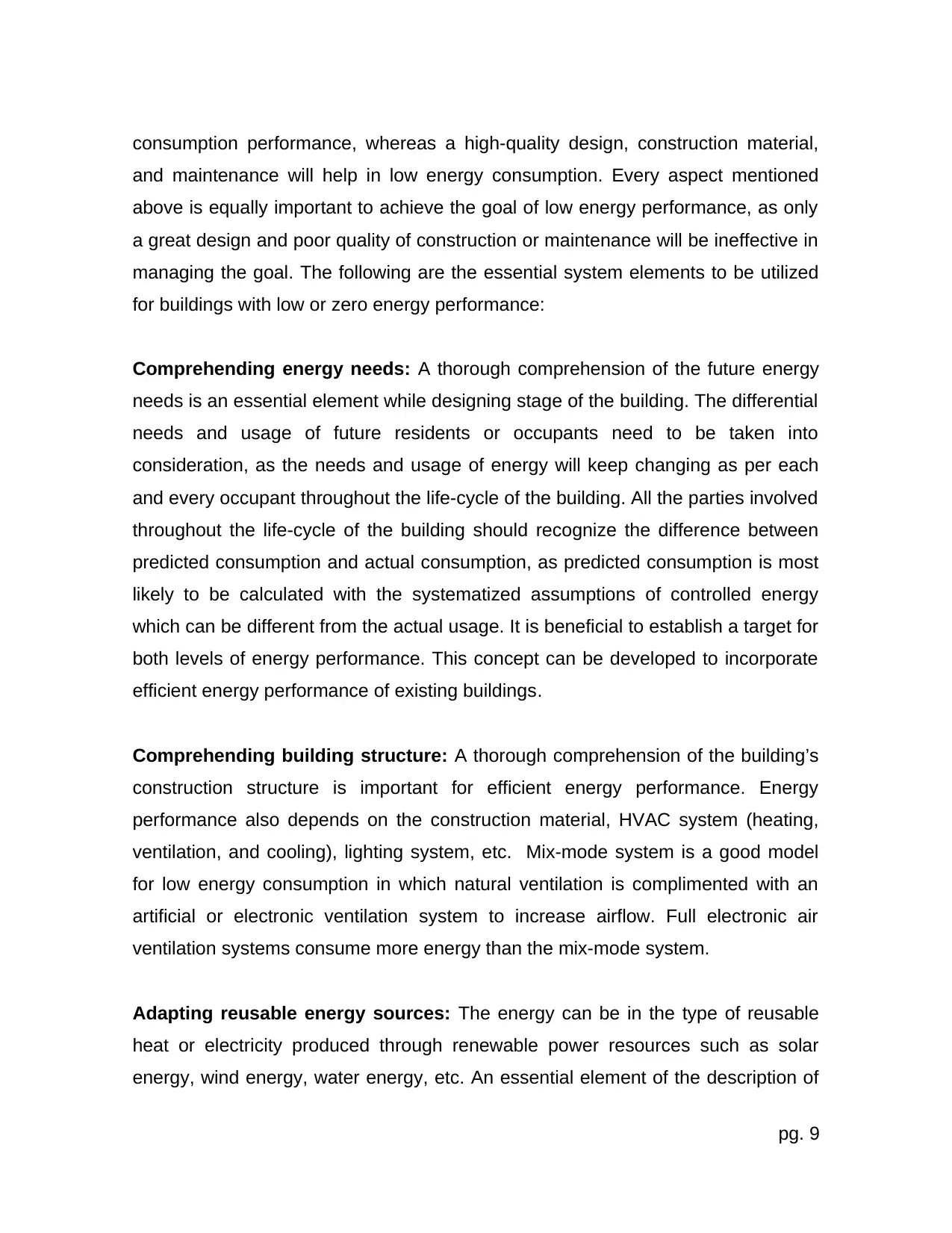
consumption performance, whereas a high-quality design, construction material,
and maintenance will help in low energy consumption. Every aspect mentioned
above is equally important to achieve the goal of low energy performance, as only
a great design and poor quality of construction or maintenance will be ineffective in
managing the goal. The following are the essential system elements to be utilized
for buildings with low or zero energy performance:
Comprehending energy needs: A thorough comprehension of the future energy
needs is an essential element while designing stage of the building. The differential
needs and usage of future residents or occupants need to be taken into
consideration, as the needs and usage of energy will keep changing as per each
and every occupant throughout the life-cycle of the building. All the parties involved
throughout the life-cycle of the building should recognize the difference between
predicted consumption and actual consumption, as predicted consumption is most
likely to be calculated with the systematized assumptions of controlled energy
which can be different from the actual usage. It is beneficial to establish a target for
both levels of energy performance. This concept can be developed to incorporate
efficient energy performance of existing buildings.
Comprehending building structure: A thorough comprehension of the building’s
construction structure is important for efficient energy performance. Energy
performance also depends on the construction material, HVAC system (heating,
ventilation, and cooling), lighting system, etc. Mix-mode system is a good model
for low energy consumption in which natural ventilation is complimented with an
artificial or electronic ventilation system to increase airflow. Full electronic air
ventilation systems consume more energy than the mix-mode system.
Adapting reusable energy sources: The energy can be in the type of reusable
heat or electricity produced through renewable power resources such as solar
energy, wind energy, water energy, etc. An essential element of the description of
pg. 9
and maintenance will help in low energy consumption. Every aspect mentioned
above is equally important to achieve the goal of low energy performance, as only
a great design and poor quality of construction or maintenance will be ineffective in
managing the goal. The following are the essential system elements to be utilized
for buildings with low or zero energy performance:
Comprehending energy needs: A thorough comprehension of the future energy
needs is an essential element while designing stage of the building. The differential
needs and usage of future residents or occupants need to be taken into
consideration, as the needs and usage of energy will keep changing as per each
and every occupant throughout the life-cycle of the building. All the parties involved
throughout the life-cycle of the building should recognize the difference between
predicted consumption and actual consumption, as predicted consumption is most
likely to be calculated with the systematized assumptions of controlled energy
which can be different from the actual usage. It is beneficial to establish a target for
both levels of energy performance. This concept can be developed to incorporate
efficient energy performance of existing buildings.
Comprehending building structure: A thorough comprehension of the building’s
construction structure is important for efficient energy performance. Energy
performance also depends on the construction material, HVAC system (heating,
ventilation, and cooling), lighting system, etc. Mix-mode system is a good model
for low energy consumption in which natural ventilation is complimented with an
artificial or electronic ventilation system to increase airflow. Full electronic air
ventilation systems consume more energy than the mix-mode system.
Adapting reusable energy sources: The energy can be in the type of reusable
heat or electricity produced through renewable power resources such as solar
energy, wind energy, water energy, etc. An essential element of the description of
pg. 9
Paraphrase This Document
Need a fresh take? Get an instant paraphrase of this document with our AI Paraphraser
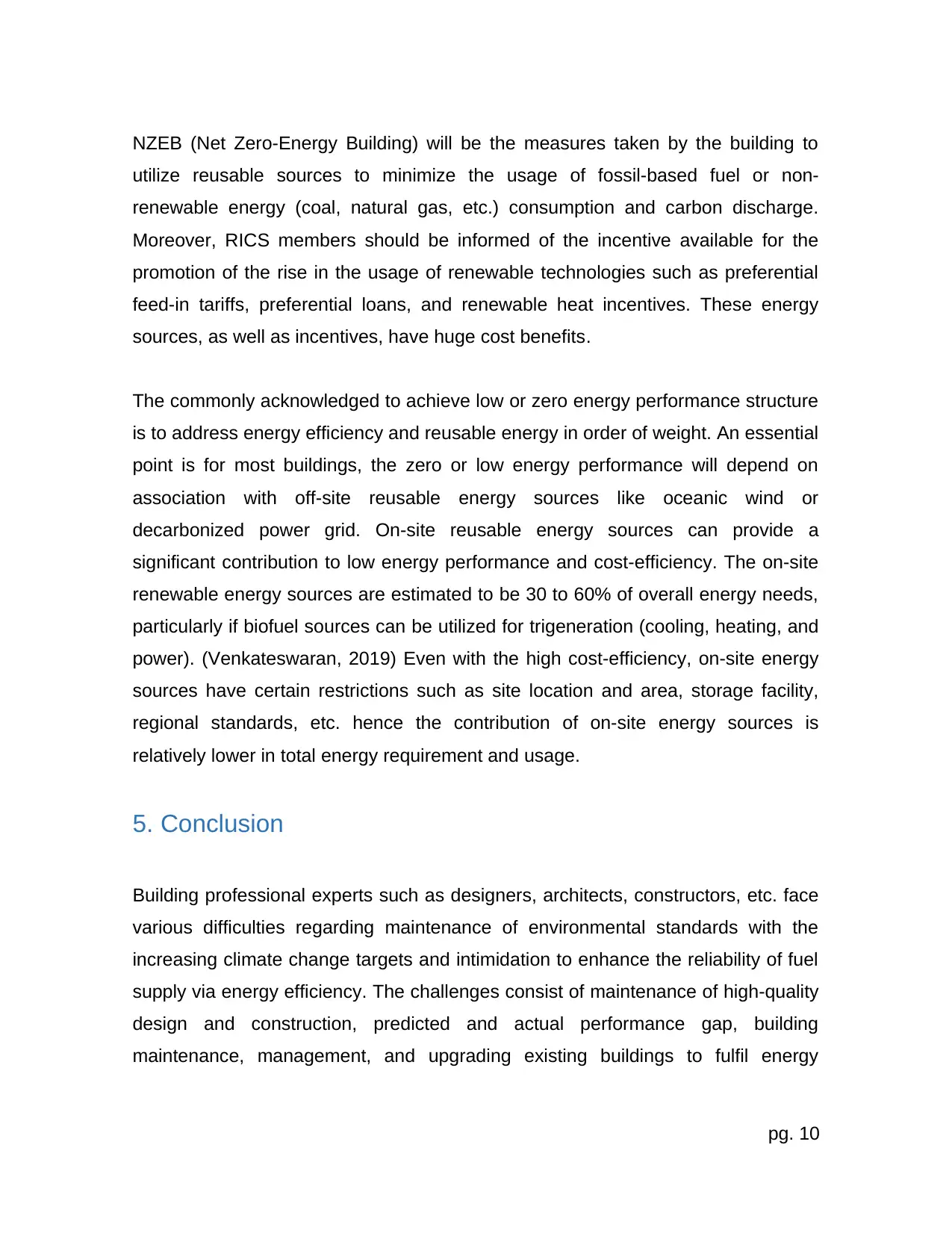
NZEB (Net Zero-Energy Building) will be the measures taken by the building to
utilize reusable sources to minimize the usage of fossil-based fuel or non-
renewable energy (coal, natural gas, etc.) consumption and carbon discharge.
Moreover, RICS members should be informed of the incentive available for the
promotion of the rise in the usage of renewable technologies such as preferential
feed-in tariffs, preferential loans, and renewable heat incentives. These energy
sources, as well as incentives, have huge cost benefits.
The commonly acknowledged to achieve low or zero energy performance structure
is to address energy efficiency and reusable energy in order of weight. An essential
point is for most buildings, the zero or low energy performance will depend on
association with off-site reusable energy sources like oceanic wind or
decarbonized power grid. On-site reusable energy sources can provide a
significant contribution to low energy performance and cost-efficiency. The on-site
renewable energy sources are estimated to be 30 to 60% of overall energy needs,
particularly if biofuel sources can be utilized for trigeneration (cooling, heating, and
power). (Venkateswaran, 2019) Even with the high cost-efficiency, on-site energy
sources have certain restrictions such as site location and area, storage facility,
regional standards, etc. hence the contribution of on-site energy sources is
relatively lower in total energy requirement and usage.
5. Conclusion
Building professional experts such as designers, architects, constructors, etc. face
various difficulties regarding maintenance of environmental standards with the
increasing climate change targets and intimidation to enhance the reliability of fuel
supply via energy efficiency. The challenges consist of maintenance of high-quality
design and construction, predicted and actual performance gap, building
maintenance, management, and upgrading existing buildings to fulfil energy
pg. 10
utilize reusable sources to minimize the usage of fossil-based fuel or non-
renewable energy (coal, natural gas, etc.) consumption and carbon discharge.
Moreover, RICS members should be informed of the incentive available for the
promotion of the rise in the usage of renewable technologies such as preferential
feed-in tariffs, preferential loans, and renewable heat incentives. These energy
sources, as well as incentives, have huge cost benefits.
The commonly acknowledged to achieve low or zero energy performance structure
is to address energy efficiency and reusable energy in order of weight. An essential
point is for most buildings, the zero or low energy performance will depend on
association with off-site reusable energy sources like oceanic wind or
decarbonized power grid. On-site reusable energy sources can provide a
significant contribution to low energy performance and cost-efficiency. The on-site
renewable energy sources are estimated to be 30 to 60% of overall energy needs,
particularly if biofuel sources can be utilized for trigeneration (cooling, heating, and
power). (Venkateswaran, 2019) Even with the high cost-efficiency, on-site energy
sources have certain restrictions such as site location and area, storage facility,
regional standards, etc. hence the contribution of on-site energy sources is
relatively lower in total energy requirement and usage.
5. Conclusion
Building professional experts such as designers, architects, constructors, etc. face
various difficulties regarding maintenance of environmental standards with the
increasing climate change targets and intimidation to enhance the reliability of fuel
supply via energy efficiency. The challenges consist of maintenance of high-quality
design and construction, predicted and actual performance gap, building
maintenance, management, and upgrading existing buildings to fulfil energy
pg. 10
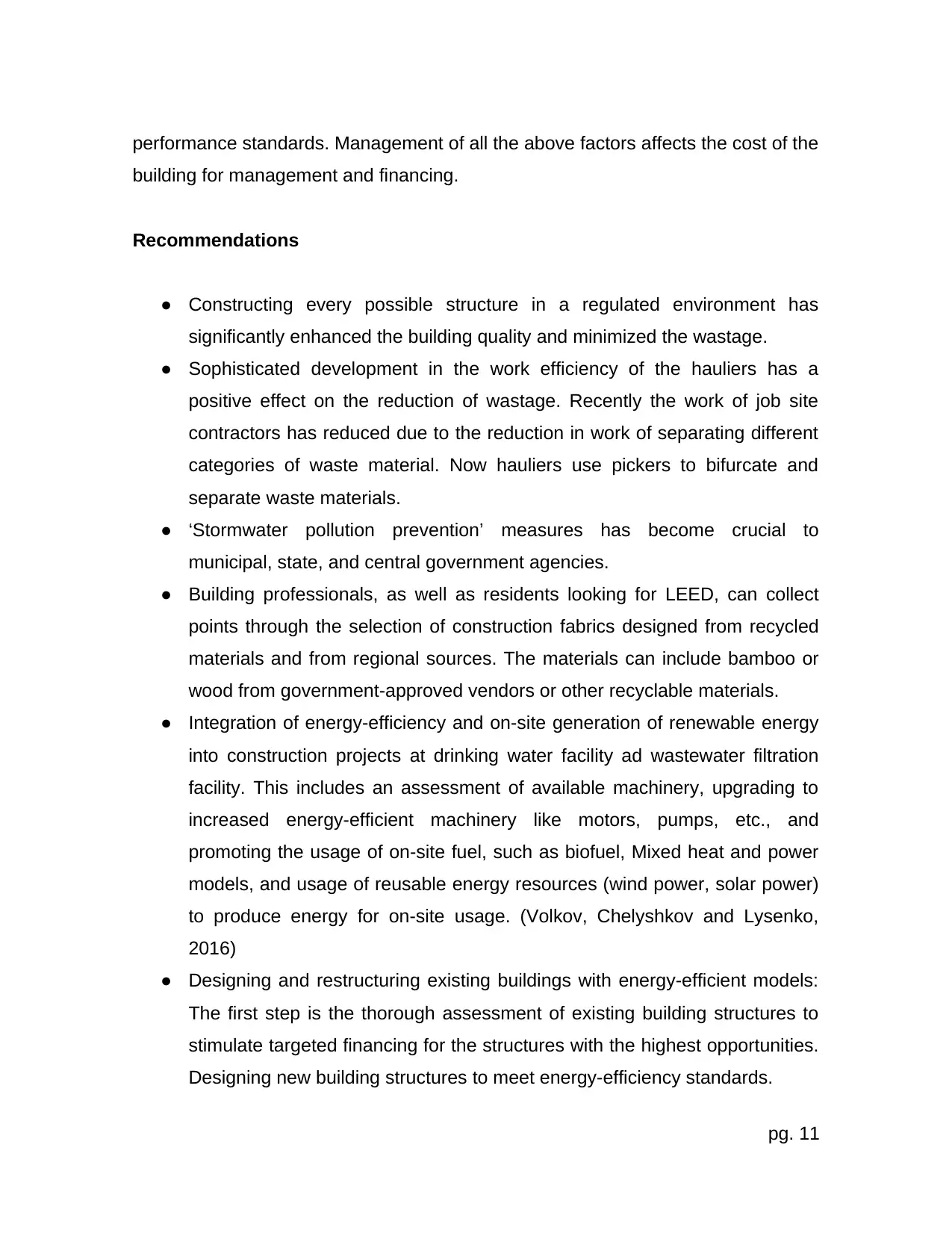
performance standards. Management of all the above factors affects the cost of the
building for management and financing.
Recommendations
● Constructing every possible structure in a regulated environment has
significantly enhanced the building quality and minimized the wastage.
● Sophisticated development in the work efficiency of the hauliers has a
positive effect on the reduction of wastage. Recently the work of job site
contractors has reduced due to the reduction in work of separating different
categories of waste material. Now hauliers use pickers to bifurcate and
separate waste materials.
● ‘Stormwater pollution prevention’ measures has become crucial to
municipal, state, and central government agencies.
● Building professionals, as well as residents looking for LEED, can collect
points through the selection of construction fabrics designed from recycled
materials and from regional sources. The materials can include bamboo or
wood from government-approved vendors or other recyclable materials.
● Integration of energy-efficiency and on-site generation of renewable energy
into construction projects at drinking water facility ad wastewater filtration
facility. This includes an assessment of available machinery, upgrading to
increased energy-efficient machinery like motors, pumps, etc., and
promoting the usage of on-site fuel, such as biofuel, Mixed heat and power
models, and usage of reusable energy resources (wind power, solar power)
to produce energy for on-site usage. (Volkov, Chelyshkov and Lysenko,
2016)
● Designing and restructuring existing buildings with energy-efficient models:
The first step is the thorough assessment of existing building structures to
stimulate targeted financing for the structures with the highest opportunities.
Designing new building structures to meet energy-efficiency standards.
pg. 11
building for management and financing.
Recommendations
● Constructing every possible structure in a regulated environment has
significantly enhanced the building quality and minimized the wastage.
● Sophisticated development in the work efficiency of the hauliers has a
positive effect on the reduction of wastage. Recently the work of job site
contractors has reduced due to the reduction in work of separating different
categories of waste material. Now hauliers use pickers to bifurcate and
separate waste materials.
● ‘Stormwater pollution prevention’ measures has become crucial to
municipal, state, and central government agencies.
● Building professionals, as well as residents looking for LEED, can collect
points through the selection of construction fabrics designed from recycled
materials and from regional sources. The materials can include bamboo or
wood from government-approved vendors or other recyclable materials.
● Integration of energy-efficiency and on-site generation of renewable energy
into construction projects at drinking water facility ad wastewater filtration
facility. This includes an assessment of available machinery, upgrading to
increased energy-efficient machinery like motors, pumps, etc., and
promoting the usage of on-site fuel, such as biofuel, Mixed heat and power
models, and usage of reusable energy resources (wind power, solar power)
to produce energy for on-site usage. (Volkov, Chelyshkov and Lysenko,
2016)
● Designing and restructuring existing buildings with energy-efficient models:
The first step is the thorough assessment of existing building structures to
stimulate targeted financing for the structures with the highest opportunities.
Designing new building structures to meet energy-efficiency standards.
pg. 11
⊘ This is a preview!⊘
Do you want full access?
Subscribe today to unlock all pages.

Trusted by 1+ million students worldwide
1 out of 15
Your All-in-One AI-Powered Toolkit for Academic Success.
+13062052269
info@desklib.com
Available 24*7 on WhatsApp / Email
![[object Object]](/_next/static/media/star-bottom.7253800d.svg)
Unlock your academic potential
Copyright © 2020–2025 A2Z Services. All Rights Reserved. Developed and managed by ZUCOL.


